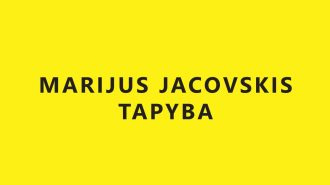Increasingly frequent use of the word ‘capitalism’ denotes a time of crisis. After the 90s it became a household word. Eventually there was no point in stressing it. Social and political discourses are divided through different ideologies and beliefs, they often get lost in ideologically biased discussions. So again, we talk about capitalism when certain issues concerning our existence become evident and undeniable. What also makes us speak about it, is a critical mass of people who become knowledgeable about the increasingly changing world and the loss of stability.
Societies in the Baltics became one-dimensional as things like social justice and leftist thought became compromised as well as dialectically negated together with their soviet past. We ought to struggle against neoliberalism, which is often understood as a doctrine, but not recognized as an ideology. This ideology is turned into a hegemony, but its features are presented to us as natural and permanent.
The process could be seen in both local and global perspectives. As for the latter, the discussions about whether the influx of refugees would pay off or whether education is economically efficient makes it sorely evident that neoliberalism as an ideology permeates through every aspect of our lives. Both cases are incompatible with the values so fervently cherished on the surface of our society. So this is the time of crisis, but it cannot be understood by an instrumental logic. One of the tasks for us then is to acknowledge it as an ideology and think of the alternatives and means of resistance, while it threatens to eliminate anything but relations of property, money and power.
We must acknowledge neoliberalism as an ideology to begin with
Edvardas Šumila: In the opening lines of the description of your recent exhibition ‘Imagining The Future’ (18.9-11.10.2015, Y Gallery, Tartu) you consider neoliberalism as either an ideology or a condition of our society today. Could you share some of your thoughts on how neoliberalism appears to you and how you recognize it?
Jaana Kokko: Often when we talk about idealism or ideology, we tend to think of it as a past thing – like socialism or communism were certain ideologies. And at least in the Western world, we tend to attach some particles or attributes to it – communism or socialism, and define what it is or was. A certain kind of art was part of it – as means of propaganda for a certain ideology. But what is missing is a discussion about neoliberalism as an ideology. And I think it should be not only artists who must underlie that it is an existing phenomena and that certain things are constantly happening, as well as things that we do in order to supplement it. One of the main principles where I see neoliberalism at work is the ideal of a certain individuality, a certain state of human being who is surviving alone. We often think that this means we survive as individuals if we have enough money.
E. Maybe it is a kind of egocentrism in a way?
J. I think it can also be called egocentrism or egoism. But it is a lie that one would achieve a well-being all alone, based on his or hers qualities. Nothing happens to us without social relations, without social understanding and support. I mean, no job, no fortune, nothing will happen just like that [snaps her fingers]. And this is what disturbs me the most – a kind of false way to interpret the welfare.
E. Perhaps we can make a distinction between being related to someone and making use of someone. You can be a part of the community and at the same time you can have business relations and merely seek your own advantage. Maybe this could be a distinctive feature of neoliberalism which perhaps differs from the pre-modern relations in the society. But I always felt ambivalent towards art and capitalism, because if the whole concept of art could be considered as a product of capitalism, there were no such thing as art in a modern sense. Let’s say in the 16th century it was rather a different thing. So I was wondering if it is possible for the established art to take a critical stance towards capital. Can it be counter-capitalist and counter-neoliberal?
J. It’s not only this question whether it is a product to sell or whether it is something immaterial. Money has always been a part of art, I mean from the beginning of 16th century onwards, when, for example artists started to paint the portraits, they were paid by the noble class because portraits were made for them. It was also a starting point for today’s Western individuality, because there were no individual portraits of people before in that sense. And it was a part of their job, artists were commissioned to work. There are some great examples of this in the art history, like the paintings by Hans Holbein junior.
E. But until the 19th century art would have always had a social function, art in the modern sense is removed from its environment and put into the museum or gallery and I think this is a very important distinction that separates today and premodern art, or 16th century art. The accumulation of value of the artwork is also a capitalist notion, would you agree with that?
J. Yes, but there is always art that doesn’t have value in the capitalist sense. There is always art not to be commodified. Maybe the problem at the moment is how do we support this kind of counter-capitalist art. Where does this support come from? For these artists that are continuously working with social, economic, or political issues, or any critical issues. But the support for art must come not only from capital and money – the support should come from the society itself in all its forms. It is an advantage for the society itself to have critical voices.
E. While observing your pieces I would recognize, that the effects and problematics of your work in particular coincides with functions of critical theory today. For example giving critical opinions on certain notions, revealing discourses and at the same time offering no practical or pragmatic solution. It is a critique in a way that it has no other purpose than to acknowledge the problem more or less without solving the problems which constitute a whole which must be addressed. And I would rather think it’s also impossible to offer a solution to solve a problem thoroughly.
J. To give a solution in the work?
E. I don’t believe it might give a solution, because the problems are complex, it might hint to the guidelines or point to the problems, that’s why I would like to associate it more with critique than a program.
J. Are you thinking of some particular work of mine?
E. Well, let me think. Was it “Reading group”?
J. Actually in that particular work there is a sort of practical solution included, because they [women, characters of the film] are confronting, troubles and problems, practical as well as theoretical, while trying to solve the feminist way of living they gather together. The notion of political by Hannah Arendt is included there quite boldly, that political is something that is situated in between us and that we should continue to gather together to practice our quality as human beings. And that is the only possibility that we can hold against the alienation of the nature, world, society – of everything. And one of the main problems of modern human is becoming subject to alienation.
E. What I was thinking about and what was really interesting for me was that in your work all the women seem to have different opinion, they try to work it out through a dialectical process – i.e., by speaking out different views. These observations are meant to capture our attention. Could we say that the purpose of the work is observation of problems, along with marking out the problems of society? All the women in your work have different opinions and they try to work it out in this dialectical process of speaking out different views. Furthermore these observations are quite important and they catch our attention. Could the purpose of the work be observing the problems – giving them a glance? And maybe marking out the problems of society?
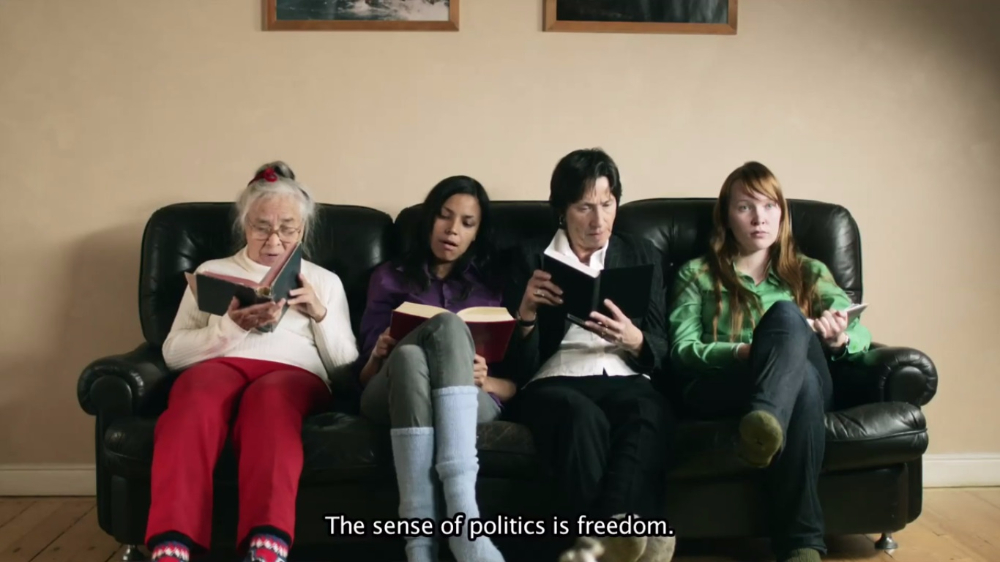
Jaana Kooko, The REading Circle, 2010, film still.
Ways of working
J. I agree, definitely. I created the characters so they talk from different points of views because this is often how it is: we have our own goals in the conversation and we might be talking not about the subject but around the subject. The discussion becomes a polylog, even though I used some Socratic dialogues when I wrote the film script for the characters of Student and Elderly Lady.
Often when I start working with something I don’t know the exact problem yet, I cannot name what it is. Only after I have finished the work – like a video or an artwork with multiple parts – there comes a time of understanding. I realise what was it that I was actually questioning and what the point was. This is why during the process I prepare so many questions, also questions that don’t go to the point: by asking them I am trying to reveal what is this problem or an interesting phenomenon that I should question. And then I try to find it.
E. How do you try to find it?
J. By preparing more questions. I often make a lot of interviews before I start making a specific video, so I often work with another camera and make interviews. And after that, I write the script.
E. And how do these questions come up in the first place?
J. It depends on the work. Maybe it’s not the theme but what is the issue in the work for example. I don’t know if you saw “Haven” that is now shown in Tartu? The questions there are prerecorded and played back, they are not the original questions that I asked these women; they were purposely made to resemble those rather normal questions about everyday life and they have nothing to do with anything theoretical, really. In this work I came up with these questions because I wanted to know if the ideal of a woman was different during the socialism compared to contemporary times.
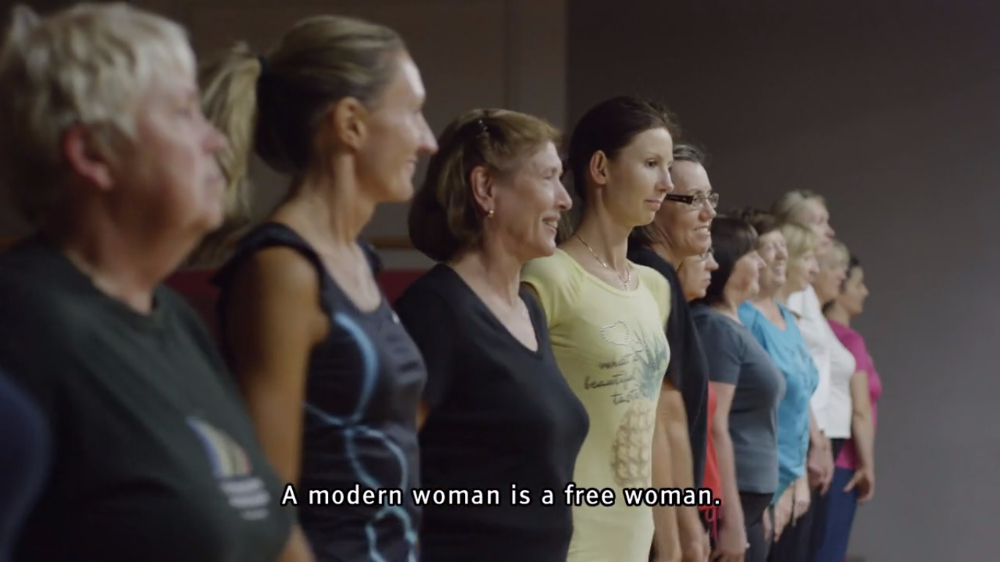
Jaana Kokko, Haven, 2013-2015, film still.
Artist, society and capital
E. Do you worry that the public perception eventually turns an artist into a popular figure which might change the perception of art and as well strengthen the commodification of values – precisely the issues you are trying to bring up?
J. I don’t know if artists who are dealing with social or political issues critically could really become popular, if we assess the popularity by the number of appearances in the museums or the amount of sold artworks artworks, which, as we well know, often go hand in hand. To become a popular political artist, like Alfredo Jaar or, in Finland’s case, Jani Leinonen, you need an artwork which is not too complex and not too avant-garde. By avant-garde I mean that the work follows the art language already recognized by the markets. Also you need a proper communication and media work, often also a proper personal link to a museum or art markets. Whether I worry about the popular political art overdriving or swallowing the groundbreaking and important critical art is, perhaps, not the key question, because it is happening already. The question might be, how does the society support art places and institutions that are providing the space for critical art, because the society needs it’s critical voices. For example if decisions for the governmental support for arts were made by art professionals – like artist themselves and not by politicians or bureaucrats – it would be one way to sustain the alternative critical art and art places.
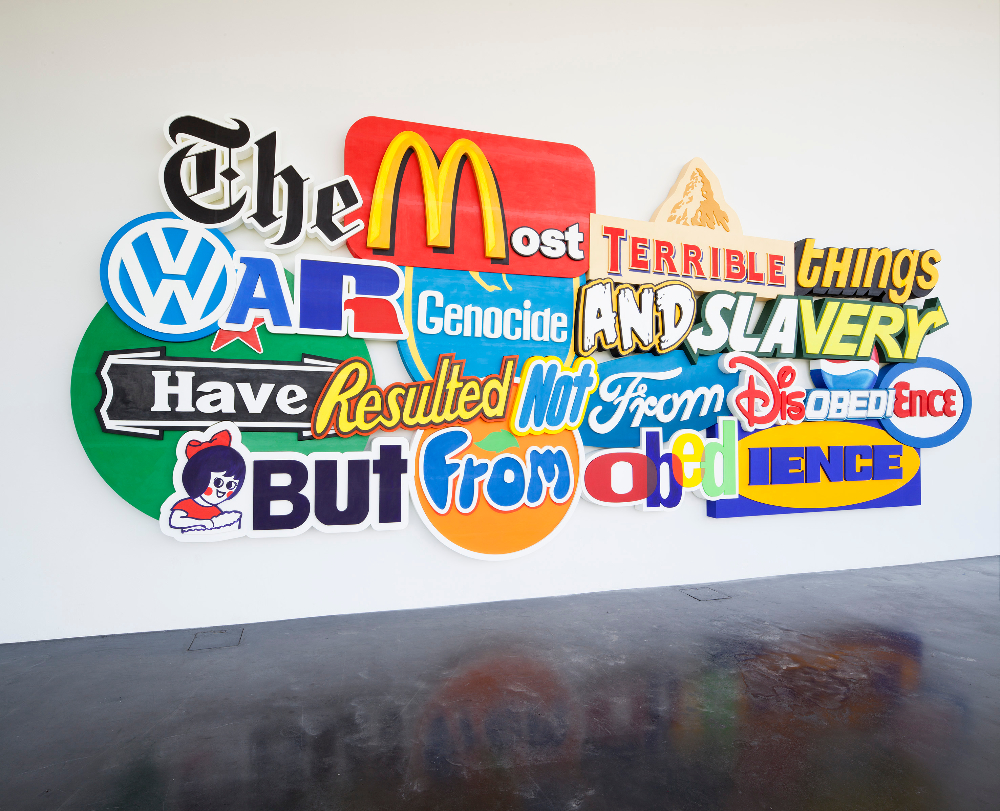
Jani Leinonen, The Most Terrible Things, 2015, acrylic on polystyrene. In possession of the artist. Photo: Finnish National Gallery / Pirje Mykkänen
E. But still I would say that they could be commodified in a way. Maybe it depends on circumstances, even if we think about art that was supposed to be anti-art, or something revolutionary or things like that, at some point it still goes to a gallery and becomes a commodity, are you aware of this?
J. Yes. I understand it. And at the moment there is a tendency to commodify political and social art. It is in the air. It is a tendency at the moment.
E. I would say it is very neoliberal in a way. Well, how do you deal with it personally? Do you get to sell your art? Do you get support from the Finnish culture foundations?
J. Some works of mine are in the public collections and the support I receive for the production comes from foundations. In general my basic income comes from teaching art at the university.
E. Would you agree that belonging to some branch of art or having a certain background could be commodified and embedded into purely capitalist relations?
J. Artists from post-soviet countries are asked to be part of exhibitions because of their background of living in socialist country and it is already happening.
E. So artists are asked to be part of exhibitions because of their past? That also could be seen as a Commodified past?
J. Yes a commodified past is a good term for it. I mean, an artist can say “no, I’m not participating”, others will say “yes I will”, because they want to be on display and they want to show their works. One could see it as an ethical problem to be part of the curated fashion show but one could also ask: why not be on display and take the advantage out of the system if one believes in his/ her work and it’s criticality and influences on the audience.
E. I encountered two essential questions in your description, one was ‘how to recognize capitalism?’ So here I would like to discuss whether you think capitalism is fragmental and recognizable in different areas of our lives? That also implies another question – are there any aspects of one’s life that are untouched or so to say not involved into capitalist relations?
J. Of course, I mean capitalism is always a question of oppression, capitalism needs exploitation. It cannot function otherwise. We could say that oppression and is food of capitalism. It will always grow and it will stay alive if only there is oppression and exploitation. But are there any non-capitalist relations? Of course there are. For example if you take care of your friends and people and think you are equal with them.
E. That’s beautiful.
J. If you start from that, it is something totally different. And of course that’s on a personal level but these notions should be included into the nations and societies and the so-called races – i.e., that we are all equal, all the people are equal. If you think about the most of the former Scandinavian welfare countries, this thing was quite evident; people should have equal possibility to have a house or rather place where they live and equal possibility for education, but now it’s changing.
E. Would you say that the welfare state is not there anymore? Is it already over?
J. Well it’s not totally over, of course there are small but loud leftist groups that are trying to keep it alive. Possibilities to have education for free for example. Welfare society as it was in the 70s was a kind of mix a of socialist ideas and ideas that were based on private ownership, but because of capitalism we are now losing the socialist part – not totally yet, but we have to fight for it not to vanish. There is a growing amount of Finnish politicians eager to cut the welfare.
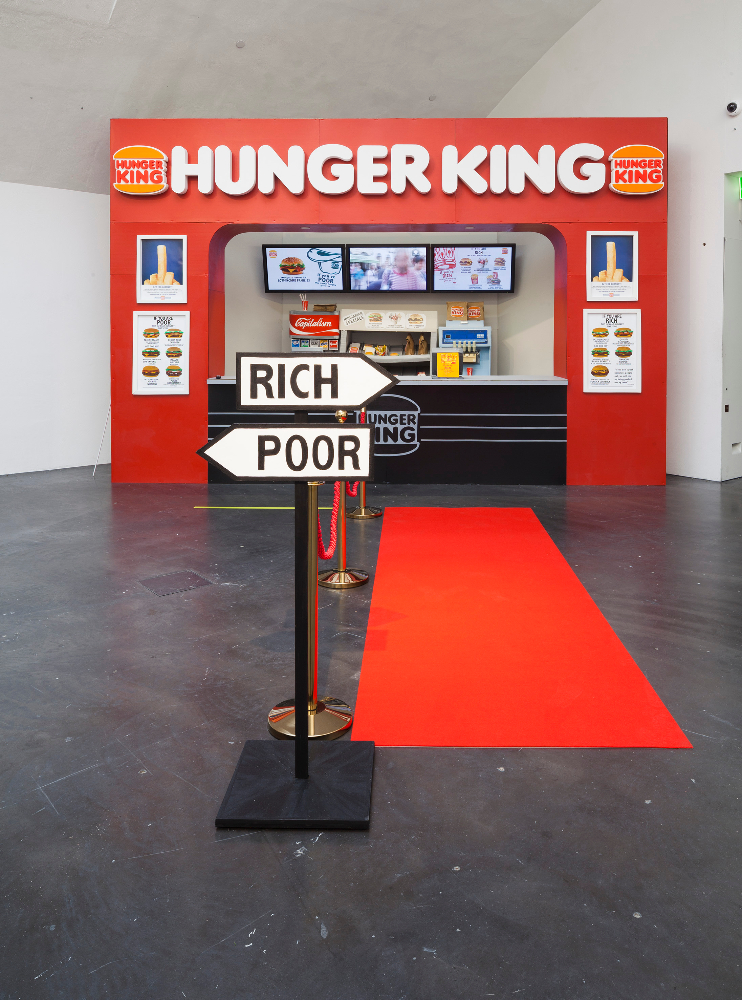
Jani Leinonen, Hunger King, 2014, installation. In possession of the artist. Photo: Finnish National Gallery / Pirje Mykkänen
E. I can feel this trend very much even when I think about Lithuania. It became independent in 1990 and it was a transition from soviet period to capitalism, but when I think about my childhood because I was born in 1990, I think there were more things considering welfare which were still there even if you think about an education which is not part of the curriculum where you could go after school, as well as healthcare and all the other things which are vanishing or gone, because the transition was very radical, it was a jump directly to neoliberalism.
J. Sorry, again when were you born? 19..?
E. 90.
J. Yes. What happened in Lithuania and Latvia as well as in Estonia in the 1990´s, – among other things – was that the business of Scandinavian countries started to take part in your economy. You were very cheap workers for us and that is why in the 90s Scandinavian capitalists could still could benefit. What I mean by this is that people in those countries also got commodified, because they were cheap labor.
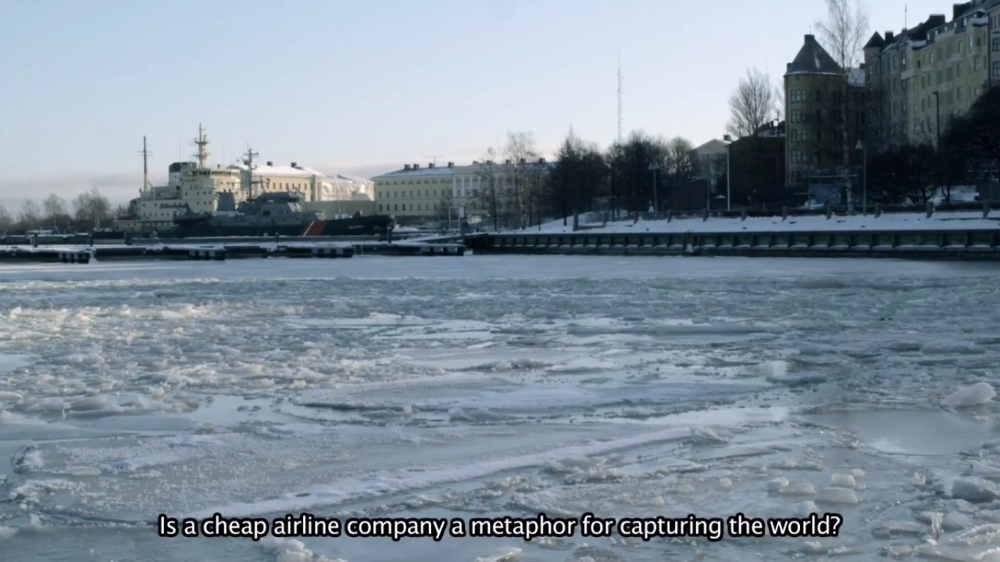
Jaana Kooko, The REading Circle, 2010, film still.
E. Lithuania is where the labor power is still one of the cheapest in Europe, of course there are Bulgaria and Romania where things are probably even worse.
J. Yes, and some of the investors have already moved out from Lithuania. Last year I was talking with a Finnish businessman on an airplane to Vilnius about the reasons why he came here in the 90s and what he’s been doing and why he was leaving and where he was heading for. That discussion involved some of the very basic information about the logic of global capitalism, and it was also very straightforward – about how it worked then and how it works now.
E. Could you share a bit of this information?
J. It is the idea of the global capitalist entrepreneurship. You will need a place where labor as well as housing and land is cheap. Also, perhaps there are no taxes, or only small taxes. So everything what the owners can do, they do it there, in this place. The companies move their headquarters there and work there within the framework of local taxation. They use the advantages they could not get, for example, in Finland where the tax rate is relatively high, which is of course the basis of a welfare society. And now, if there would be proper rights for the workers in Lithuania and a decent minimum salary or some kind of European legislation to prevent this, the companies would not be able to do that. And that’s the logic of capitalism – it always needs oppression. You don’t need to go to Indonesia or Bangladesh to do this, you can go to post-Soviet countries.
E. I think it’s not over yet because we have new Labour Code – the law of relations between employer and employee. I think it is even more open for exploitation. Longer working hours as well as loosened employment rules – allowing to fire employees more easily. But another question was “How to resist capitalism.” Would you see the resistance in our everyday lives as ultimate “getting rid of”? And what could be the measures of such resistance?
J. One thing is information and education, we have to talk about these things. We should teach that it is not really okay to have a worker who doesn’t have rights – that is of course the basic point. It should be raised to a state level, there must be some kind of support to these countries that are subject to continuing oppression. And the question is not about bad or good conditions – conditions should be equal. People should also be educated about how to ensure or control the tax payment. On the one hand, it is a basic thing, but if somebody builds a factory in the country, the money earned should not be just removed from that country but also left for the people who live there. For me it would be okay if somebody from Finland goes to these post-soviet countries and puts up a factory, but it has to be fair toward the local conditions, otherwise all the investments and money will go abroad. On a personal level as an artist you can work with these issues and point out these issues.
E. So again, pointing out is very important.
J. Another crucial global point that comes together with the equality of worker rights is environment. If nobody cares about environment and if there are no common rules for the companies to preserve environment the disaster will go everywhere, the environmental disaster is evidently global – it’s not the question of the country of origin. These both points are of course something that politicians cannot agree globally.
E. You also have a background in both arts and economics, but the notion of capitalism in your work is very broad and I would say that economics is only a small part of it. Would you agree?
J. Maybe the economic issue is evident in a sense that we often think that if economy is alright everything else will solve by itself. As well as thinking that you can rule the world with economics. There are also other things – philosophical, social and cultural questions that go with that.
E. Does having been educated in economics help you in your work after all?
J. Well, I think all kinds of education is important. For your self-knowledge and for understanding, getting a bigger picture of what’s going on and what is important. So I would answer yes, it helps me in my work, but also it helps me to understand and have a stance toward certain phenomena. When I was younger I went through quite a struggle with the studies, but my problem in a way is that I cannot leave things open, I need to finish them on the way or the other. During that time, late 1990’s, it was still possible to do critical studies at the school of economics so I choose them, like economic sociology, sociolinguistics and gender studies. Teachers of the subjects often shared with me the critical point of view for the consumption.
The lost education and the empowerement
E. The exhibition is followed by an educational program performed in collaboration with the University of Tartu. One of the contemporary issues in relation to capitalism and neoliberalism is cutting on public education, especially in critical studies and humanities. Technical studies, which are profession oriented are okay, because somebody does this work, but humanities and critical studies receive cuts and University of Helsinki for example is to suffer great cuts in funding, what has never happened in its history. Would you agree that this is also symptoms of neoliberal entrenchment? Welfare state was cultivated in almost all Western Europe in 60s, there was 1% unemployment in Western Germany in the 1961, which is unimaginable nowadays. Then after 1968 and student uprisings something has changed, maybe because it was thought that people have too much time to think about social issues and they’re too educated, so education should be cut. Would you agree that cutting on education is also symptoms of neoliberalism?
J. Of course. You used the word cultivated, and I think it is exactly a matter of cultivation. The importance of money or even the ideology of the capital has gone so far that we forget the ways to practice cultivation. The problem exists already in the basic education. I’ll give an example: in the socialist countries children had equal possibilities to play any instrument. To play music was one of the basic skills to learn, among other skills. In Finland playing music is not equal and the fees in order to get this basic skill are quite high. What I wanted to say is that if you are not talented it is still good for you to understand music, to play music, to draw, to paint, to understand paintings, it is cultivation of your mind. If we only concentrate on technical or economical education that is something that we can make money with in the future and keep our capitalist society going, we are not doing well, I mean as individuals and as a society. We need practice in arts for the sake of the psychology of our societies. I don’t know if I answered your question?
E. Yes and I agree, I think in ten years or so it will be a problem to get holistic education, which would encompass everything not only the technical aspects of some sort of specialization which is very narrow. And also if you had the money you could probably get a very good education, for example in private universities of United States, but you would have to pay enormous money so whether you were rich already and afterwards you are uninterested in workers rights because you are from a social class which is already oppressive, or you will take a loan that you will be eager to pay back.
J. Yes, this is one thing – the class consciousness. We should also underline that there are classes and we live in a class society. If we deny it, or if we don’t speak up for it, we lose many of educational possibilities for everybody.
E. This is in a sense very general question, but would you see art as instrumental in educating people towards critical thinking? Partly we already discussed that, maybe you have some other thoughts.
J. I remember when I was in the audience of one discussion and one woman who was sitting in the audience, I don’t know if she was unemployed, but she definitely was from a different kind of social group than all the academic artists and art students. She said to the speakers “you are talking so well, you have so much tools to survive in the society when you are doing art, I wish I would have the tool to make something like this”. And then the woman from the round table answered something like “it will not work if we taught everyone art and activism” and I really thought about it afterwards and the woman who answered. I think artists have their tools and practices that could and should be shared with others. It is not like we would know better what we are doing. But we could share the possibilities with people who have other practices. I think making art and understanding artistic practices always involves self-knowledge and, for example, understanding your class position through art makes you feel empowered by it. It is a big difference if you do not feel oppressed by your position, but you feel empowered by it! These would be kind of educational question for artists how to share this knowledge with others.
E. Is that a question of knowledge? What that woman needed was knowledge?
J. Of course we have to be careful when we talk about empowering knowledge, we cannot take the position that it is only us who are educated and we know how to do it. We probably do not know more about life than others, like the woman in the audience. But we should start from the point that we are equal and start from the equal points.
E. Absolutely.
How we work with space and how it works with us
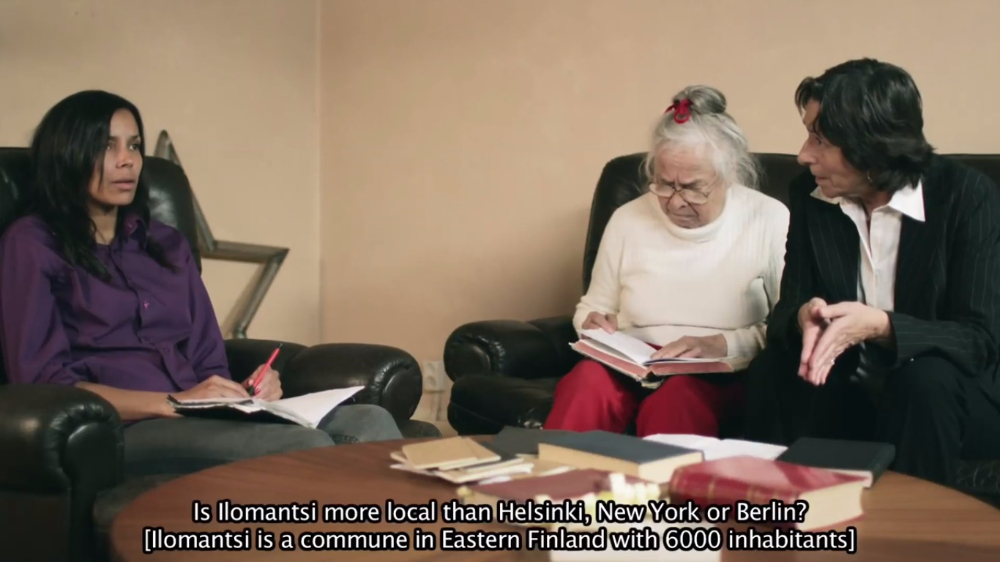
Jaana Kooko, The REading Circle, 2010, film still.
E. One of the dimensions of your work is space, so I would like to make an excursus to one of the contemporary issues that relate art, artists and capitalism – to talk a little about gentrification problems. Artists, it doesn’t matter if they are leftist attitude or not, attract capital to places, which are gentrified, making real-estate values higher and by doing this they indirectly dismantle whole communities.
J. Is this happening in Lithuania?
E. We could say that, there was one neighborhood which already went through gentrification some years ago and now we have another target – the Station neighborhood of Vilnius– gentrification is an important issue for the rest of the Lithuania as well. And when you think of some creative ideas and what you would like to do in the city space, usually the purpose is different, making a particular place more alive and interesting. But usually the effect that would come in ten years or so would be not the one that was expected. Maybe you have experience with gentrification, maybe in Helsinki.
J. Well, of course, in general the whole city center has changed in ten, twelve years maybe. Part of the artists are also involved in gentrification. What comes with this phenomena is also control over an area. So there will be more control-related issues like CCTV cameras, places that are open to everybody will not stay the same and things like this. That is always a problem in the city, where all areas except the apartments should be for everybody to share. When capital comes, the question arises who owns the place, and who is going to rule it, and what is going to happen there.
E. We could view that as an exaggeration of private property, that you can have everything and that you can buy a place and keep it just for yourself. There was a street artist in Berlin named ‘Blu’, he destroyed his own piece of art because of new buildings built just in front of his famous mural. I would rather think that this didn’t help at all, thus it accumulated more value for the same space. Would you see how it would be possible to avoid such gentrification and preserve the aura of the space? And should we attempt that?
J. Well I’m trying to think of a point of view it would be different than that of this artist. I am more concerned how gentrification and the city architecture will reflect on our social relations to other kind of people, and this is what should be avoided – areas for certain kind of people. For example if there was an area which is gentrified, there should be state or city going there and saying “there is going to be social housing in this corner and here is going to be something else” that we are going to be mix in there.
E. So this should be a part of state policy?
J. Or city policy. I mean city of Berlin would pay rent for the house owners so that they don’t sell it for investors. The investors leave the house empty. This is what happens in Berlin and then they leave for ten years and come back when the gentrification is over and prices are up. Then you let normal people live there, you give spaces for artists, you rent spaces for artists they are kind of sub-rented.
E. That sounds good and of course it’s speculative but do you think that this works? Because I’m not sure.
J. Yes, it is an issue. But considering what should be done – social relations are very important and social relations they happen inside the house and they happen outside the house.
E. We should hope that this policy would work but I can already see huge processes of gentrification when I go to Berlin especially recently in Kreuzberg and Neukolln. Recently, just few days ago a cereal shop in East London, Shoreditch was attacked by a counter-gentrification group. Have you heard about it?
J. No.
E. They were angry because the shop was selling a bowl of cereal for something like 4 or 5 pounds, not only it is expensive but it’s also part of gentrification. Two hundred people attacked the shop, it is quite a violent struggle, and maybe they didn’t make much of a damage. What are your thoughts about it? Of course it’s difficult because it was only my description.
J. Well let’s say that it is a work done by certain kind of activist group. Of course, it is one way to struggle with things, I am not sure if it is the only one, I mean there could be some other way. I cannot say.
E. The is a discussion about whether the business owners – it is a small and local business – whether they are to blame for it, but the activists claim that this is a symbol of gentrification in the area and it has to be struggled against.
J. If after this kind of attack there will be enough people to move this question forward and show this as an example it is okay. But it often occurs, especially if there was some kind of damage or violence going on, that there would be no discussion anymore – this would become a case which would be then treated in other ways. But if this is a kind of peaceful demonstration and somebody will go with it to the city, then I think it is a question of qualification, a kind of intellectual question how they will work forward with this kind of issue.
E. My final question: why is it important to keep going and keep these all these questions alive?
J. I think it is the only possibility to survive – to stay mentally alive – that we as artists or citizens criticize things in our society. We should keep on raising these questions and we should gather together. We need to gather together both locally and globally, like we are doing right now. Gather together in order to find an alternative to the egoistic society, but also in order to become empowered.








